Edible plants
- Fruit – In common language usage, fruit normally means the fleshy seed-associated structures of a plant that are sweet or sour and edible in the raw state, such as apples, oranges, grapes, strawberries, bananas, and lemons. On the other hand, the botanical sense of "fruit" includes many structures that are not commonly called "fruits", such as bean pods, corn kernels, wheat grains, and tomatoes.[2][3]
- Edible tubers – Not all tubers are edible. Those that are include potatoes, sweet potatoes and yams. Tubers are various types of modified plant structures that are enlarged to store nutrients. They are used by plants to survive the winter or dry months, to provide energy and nutrients for regrowth during the next growing season, and as a means of asexual reproduction.[4] There are both stem and root tubers.
- Vegetables – In culinary terms, a vegetable is an edible plant or its part, intended for cooking or eating raw.[5]
- Several culinary fruits
Edible fungi
 Commercial cultivated Japanese edible mushroom species
Commercial cultivated Japanese edible mushroom species - Edible fungi – Edible fungi are the fleshy and edible fruit bodies of several species of macrofungi (fungi which bear fruiting structures that are large enough to be seen with the naked eye). They can appear either below ground (hypogeous) or above ground (epigeous) where they may be picked by hand.[6] Edibility may be defined by criteria that include absence of poisonous effects on humans and desirable taste and aroma.[7][8]
Edible nuts and seeds
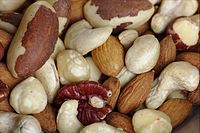 Raw mixed nuts
Raw mixed nuts  Rice is the seed of the monocot plants Oryza sativa (Asian rice) or Oryza glaberrima (African rice). Pictured is a mixture of brown, white, and red indica rice, (also containing wild rice).
Rice is the seed of the monocot plants Oryza sativa (Asian rice) or Oryza glaberrima (African rice). Pictured is a mixture of brown, white, and red indica rice, (also containing wild rice). - Edible nuts and seeds – Nut is a fruit composed of a hard shell and a seed, where the hard-shelled fruit does not open to release the seed (indehiscent). In a culinary context, a wide variety of dried seeds are often called nuts, but in a botanical context, only ones that include the indehiscent fruit are considered true nuts. The translation of "nut" in certain languages frequently requires paraphrases, as the word is ambiguous.
- Many seeds are edible and the majority of human calories comes from seeds,[9] especially from cereals, legumes and nuts. Seeds also provide most cooking oils, many beverages and spices and some important food additives.
Legumes
 A selection of various legumes
A selection of various legumes - Edible legumes
- Legumes are grown agriculturally, primarily for their food grain seed (e.g., beans and lentils, or generally pulse), for livestock forage and silage, and as soil-enhancing green manure. Legumes are notable in that most of them have symbiotic nitrogen-fixing bacteria in structures called root nodules. Well-known legumes include: alfalfa, clover, peas, beans, lentils, lupins, mesquite, carob, soybeans, peanuts, and tamarind.
You received this message because you are subscribed to the Google Groups "1top-oldtattoo-1" group.
To unsubscribe from this group and stop receiving emails from it, send an email to 1top-oldtattoo-1+unsubscribe@googlegroups.com.
To view this discussion on the web visit https://groups.google.com/d/msgid/1top-oldtattoo-1/CAGNPKmmp9JDjxs9dh6b3CKRB%2B33XFhWjzSxSAcgRfG%3DWBgHxfw%40mail.gmail.com.
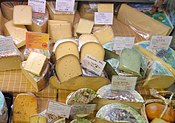

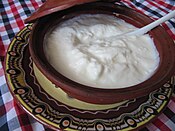

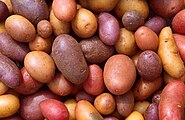
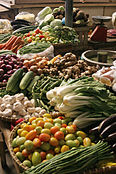

No comments:
Post a Comment